"An Advanced Technique for Grease Oxidation Measurement"
Presented at NLGI Spokesman, January/February 2015
2015
Written by Samina Azad, Savant Inc., Jonathan C. Evans, Savant Group
-- NLGI Spokeman, January/February 2015.
Abstract: Oxidation Stability is a very important property of lubricating greases. Any bench test capable of measuring this property is thus important to the degree that it is capable of predicting either or both the shelf and service life of greases. A well-known test method used to assess oxidation stability of grease is ASTM D942, which was introduced by the ASTM in 1947 and has become a standard. The method is routinely used to measure batch-to-batch grease oxidation stability. However, the Test Method states that it is not suitable for comparing the relative oxidation stability of different greases. Moreover, Test Method D942 is a very time consuming and labor intensive test requiring a comparatively large sample size thus making it non-applicable to measuring small sample sizes taken from operating bearings or other applications to determine remaining oxidation resistance. On the other hand, because ASTM D942 is relatively simple to set up and operate, it was desirable to improve this Test Method by elimination of its liquid bath, reduction of sample size and application of Fourier Transform Infrared (FTIR) analysis to extend the application of the method to comparative oxidation response of greases. Beyond this, it seemed reasonable that simultaneous analysis of several small grease sample sizes could extend the productivity of the bench test in determining grease oxidation resistance. In this paper, the authors present a modified ASTM D942 Test Method as well as further extension of the method in gaining greater efficiency with reduced sample size and simultaneous evaluation of multiple grease samples.





